Study of variability, species criteria, results of artificial selection. Laboratory work study of the results of artificial selection on the example of breeding varieties of cultivated plants
Date added: 28 October 2013 at 08:57
The author of the work: z*********@mail.ru
Kind of work: laboratory work
Attached files: 1 file
Download file
lab.docx
- 777.79 KbStudy of variability, species criteria, results of artificial selection.
Purpose: to consolidate in practice knowledge about the criteria of the species and its structure.
Work progress: 1) Compile morphological, physiological and ecological-geographical characteristics for these living organisms.
2) Compare them and draw conclusions about the species belonging of these organisms, the reasons for the similarities and differences.
3) Answer the questions:
A) Is it possible only on the basis of the criteria given to us to judge the species of organisms?
B) Justify why there are species that are similar, it would seem, in all characteristics, but not interbreeding?
C) What is a population and its role in the evolutionary process?
EARTHWATER
AMERICAN TOAD
A medium sized toad, 5 - 9 centimeters in length. Parotids are separated from the bony ridges behind the eyes, or connected to them by a short spur. Parotids are elongated. The postorbital ridges are high, without pronounced swellings. The skin of the back is covered with an enormous amount of small and medium-sized warts. Warts are also developed on the dorsal side of the lower leg. The characteristic feature is small dark spots on the back with greatly enlarged warts. The color is very variable. The basic tone ranges from yellowish brown to brown. A greenish pattern may be present on the sides. The warts are usually reddish or brown. It feeds on insects and other invertebrates. The food in captivity is insects. Distributed in North America from Labrador and Hudson Bay and Manitoba in the north to North Texas, Louisiana, central Alabama, northern Georgia and North Carolina in the south.
GRAY TOAD
The gray toad is one of the largest toads and the largest in Russia. The body length of males is 8-10 cm, females are larger - up to 20 cm, but usually about 13 cm. From above it is painted in gray, brown or gray-olive color with more or less developed dark spots-stripes. The skin of the back has rounded tubercles, sometimes with a pointed apex. The background color becomes uniform during the breeding season. Parotids are large. The male differs from the female by the presence of nuptial calluses (in the form of dark-colored compacted areas) on the 1st toe of the front foot (during the breeding season - on the 1st, 2nd, and / or 3rd), smaller body sizes and in some proportions. In the underyearling, the color is immediately reddish-brown with darker (to black) parotids. Males do not have resonators, but during breeding they attract females with single dull, thumping sounds. Distributed throughout Europe, northwest Africa and in Russia up to Sakhalin. The toad inhabits all variants of the forest and the steppe strip, is able to climb mountains up to 3000 m above sea level.
PLANTS
Dwarf birch
Deciduous, highly branched shrub 20-70 (up to 120) cm high, with erect or outstretched shoots. Young shoots are densely velvety or fluffy, later almost glabrous, with dark brown or reddish-dark brown bark. The leaf arrangement is alternate. Leaves are rounded, rarely round-oval, 5-15 mm long, 10-20 mm wide, at the base are rounded or, often, broadly wedge-shaped, with a rounded apex, wide-wedge-shaped base, with obtuse jagged edges. Above, the leaves are dark green, glossy, below are light green and absent-mindedly fluffy; sticky at a young age. Petioles are short, 4-6 mm long. The flowers are small, inconspicuous, unisexual. Catkins are sessile, erect, 5-15 (up to 20) mm long, 1.5-2 mm in diameter, with yellow anthers. Pistillate - on short pubescent legs, oval or elongated-ovate, light brown, 5-8 (with fruits up to 12) mm long, 3-5 (with fruits up to 6) mm in diameter. Bracts 2.5-3 mm long, with three upwardly directed, linear-oblong, weakly ciliated lobes. The range of the species covers almost the entire territory of Europe, except for the extremely southern regions, and almost the entire territory of Canada. On the territory of Russia, it grows in the north of the European part of Russia, in Western Siberia and Yakutia, Chukotka, Kamchatka.
FLUFFY BIRCH
Under favorable conditions, it reaches 25-30 m in height and up to 80 cm in diameter. The bark of young trees is brownish-brown, and from 8-10 years old it turns white. Juveniles can be confused with alder species. In adulthood, it differs well from other trees in its white bark; the bark almost to the very base of the trunk is white, smooth, without black cracks, only at the bottom it cracks shallowly in old age. The tree is monoecious, but catkins are dioecious. Fertile catkins 2.5-3 cm long, with pubescent legs, seed scales 3-5 mm wide, ciliate along the edge. Nutlet is about 2 mm long, oblong-elliptical. The wings are equal to or wider than the nut. It grows throughout the European part of Russia, in Western and Eastern Siberia, in the Caucasus mountains. Outside of Russia, it is distributed throughout Europe, with the exception of the Iberian Peninsula.
MAMMALS
Pallas' cat is an animal the size of a domestic cat: its body length is 52-65 cm, its tail is 23-31 cm; it weighs 2-5 kg. It differs from an ordinary cat in a more dense, massive body on short thick legs and very thick hair. The eyes are yellow, the pupils of which in bright light, in contrast to the pupils of the eyes of the domestic cat, do not acquire a slit-like shape, but remain round. On the cheeks there are bundles of elongated hair (bucks). The tail is long and thick, with a rounded tip. Pallas' cat breeds once a year. The rut takes place in February-March. Pregnancy lasts about 60 days. Kittens are born in April-May. There are 2-6 kittens in a litter, rarely more. The length of a newborn Pallas' cat is about 12 cm, weight - up to 300 g; dark spotting is noticeable in their color. Pallas' cat is widespread in Central and Central Asia, from South Transcaucasia and western Iran to Transbaikalia, Mongolia and Northwest China.
FOREST CAT
Forest cats are brown in color with black stripes. It is larger than a domestic cat, with a thick tail, as if chopped off at the end. Body size from 45 to 80 cm in length, weighing from 3 to 8 kg. The average height is about 35 cm, and the length of the tail is about 30 cm. Females reach sexual maturity after 9-10 months, while males only in the third year of life. The forest cat lives in Europe, northern Asia and Africa. It preys on small mammals, birds and other animals of similar size. Forest cats are very shy, often aggressive and try not to approach human settlements. They lead a solitary lifestyle and hold an area of about 3 km².
2) If we compare all living organisms, the main criteria for their differences, perhaps, will be their habitat and living conditions (ecological-geographical criterion). Their color will depend on external environment, that is, the toad will adapt its color to the external environment. Some of the toad species have their skin colored in one color, but other toad species have stripes on their bodies, spots on the sides, legs, or generally all over the body, which will also be an ecological and geographical factor. Or, for example, African subspecies of forest cats usually smaller and have a lighter color.
A) No, since in order to determine the belonging of an individual to some kind of insufficient one criterion, it is necessary to take into account the totality of all the criteria, in this case we lack a genetic criterion.
B) Due to the difference in the chromosome set between individuals of different species, there is reproductive isolation: the reproductive apparatus are arranged differently, sperm cannot penetrate the egg, if fertilization has occurred, then the embryo dies or a young organism is born unviable, if the hybrid is viable, then it not fertile.
C) A population is a set of individuals of a given species occupying a certain area of the territory within the species range, freely interbreeding with each other and partially or completely isolated from other populations. In reality, the species exists in the form of populations. The gene pool of the species is represented by the gene pools of populations. A population is an elementary unit of evolution.
Short description
Purpose: to consolidate in practice knowledge about the criteria of the species and its structure.
Work progress: 1) Compile morphological, physiological and ecological-geographical characteristics for these living organisms.
2) Compare them and draw conclusions about the species belonging of these organisms, the reasons for the similarities and differences.
3) Answer the questions:
A) Is it possible only on the basis of the criteria given to us to judge the species of organisms?
B) Justify why there are species that are similar, it would seem, in all characteristics, but not interbreeding?
C) What is a population and its role in the evolutionary process?
Laboratory work № 2
Study of variability, species criteria, results of artificial selection on varieties cultivated plants
Purpose: to identify the distinctive features of plants of the same species different varieties
Type of cultivated plant: upright tagetis
Tasks: Examine the features external structure plants, to determine the criteria on the basis of which plants of different varieties belong to the same species
Progress
Task 1. Study carefully general description plant species erect tagetis, determine what kind of criteria we are talking about, enter the results of the analysis into the table
"Criteria for the type of upright tagetis"
Type criterion name
Proof
Task 2. Read the description of the varieties erect tagetis
Task 3. Specify distinctive features... Enter the information in the table.
Stem height
Terry degree
Basket inflorescence type
Inflorescence color
Branchiness of the stem
Task 4. Based on the studied varieties of tagetis, draw a conclusion: what criteria indicate the belonging of all the varieties you studied to the species erect tagetis
Marigolds erect or African -Tagetes erecta
Family: Asteraceae
Homeland: Southern Mexico
The bush is compact or spreading with a distinct main shoot. Stems strongly branched, 80-120 cm tall, glabrous, erect, finely ribbed, branched, woody at the base, side shoots directed upwards, form bushes of reverse pyramidal shape. They form woody at the base.
Leaves pinnately-divided with lanceolate, sharp lobes, serrate along the edge, from light to dark green, arranged in regular order. The color of the inflorescences is monochromatic. Inflorescences are large baskets 6-15 cm in diameter, single, simple, semi-double or double, on long peduncles. Blooms from late June - early July. The color of the inflorescences is monochromatic, light yellow, yellow, bright yellow, orange or bicolor. In 1 g, up to 300 seeds that remain viable for 1-2 years.
Most of the classic terry varieties belongs to this species of marigolds.
Homeland - Southern Mexico. In culture since the 16th century.
Varieties are distinguished by height: giant - above 90 cm; high - 60-90 cm; medium - 45-60 cm; low - up to 45 cm in height.
Essential oil used in the production of oriental confectionery, in the alcoholic beverage, soap-making and perfumery and cosmetic industries. Aromatize tea with marigold flowers. V folk medicine an aqueous infusion of flower baskets was used as a urine, diaphoretic and antihelminthic agent.
The content of the essential oil of marigolds in the aerial part flowering plants- 0.30-0.55%, in the budding phase - 0.22-0.30%; it is maximal in inflorescences (0.45%) and leaves (0.28%). Essential oil yellow or Brown color, mobile, spicy floral smell with fruity tones. Its main component is ocimene (50%); D-pinene, sabinene, myrcene, limonene, n-cymene, citral, linalool, D-terpinene are also present.
Cultivated as ornamental plant... Recommended for flower beds, flower beds, high groups, vases, balconies, cutting. Erect marigolds can be grown for cutting. They stand in water for about three weeks. They are used in all types of flower beds. They are not suitable only for a pond and a shady garden.
Tagetes erecta Antigua Gold, Primrose, Orange

Variety "Antigua" belongs to the group of erect undersized - up to 20 cm high - border tegetes. Plants with a strong, branching stem. Inflorescences are large baskets 6-13 cm in diameter, single, simple, semi-double or double, on long peduncles. Abundant flowering, 25-30 inflorescences per plant, long lasting.
WITH 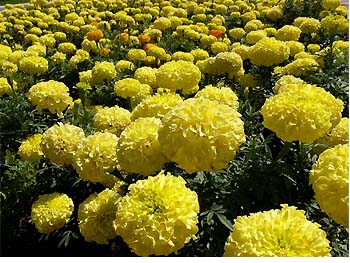 Ort Mary Helen- these are erect marigolds (tall). An excellent variety, with a high bush up to 90 cm high, terry inflorescences, clove-shaped, hemispherical up to 10-12 cm in diameter. Bright lemon-yellow, used for flower beds, ridges, tall groups against the background of a lawn, very good for cutting.
Ort Mary Helen- these are erect marigolds (tall). An excellent variety, with a high bush up to 90 cm high, terry inflorescences, clove-shaped, hemispherical up to 10-12 cm in diameter. Bright lemon-yellow, used for flower beds, ridges, tall groups against the background of a lawn, very good for cutting.
B  erect arhats Lemon Prince. One of the most common annual plants of the Astrov family. Forms a shrub 70 cm high with a distinct main shoot. Inflorescences are large (8-10 cm in diameter), densely double, spherical, lemon-yellow in color. Blooms from June to September. Photophilous and thermophilic, they do not tolerate frost. They are undemanding to soils, but they prefer fertile light soils. As a rule, they are grown in seedlings. Sowing is carried out in the second half of March and early April. Seedlings appear 4-8 days after sowing, seedlings dive in the phase of the 2nd true leaf. Seedlings are planted in early June, the distance between plants is 30-35 cm. They are used for planting in flower beds, in groups, for cutting.
erect arhats Lemon Prince. One of the most common annual plants of the Astrov family. Forms a shrub 70 cm high with a distinct main shoot. Inflorescences are large (8-10 cm in diameter), densely double, spherical, lemon-yellow in color. Blooms from June to September. Photophilous and thermophilic, they do not tolerate frost. They are undemanding to soils, but they prefer fertile light soils. As a rule, they are grown in seedlings. Sowing is carried out in the second half of March and early April. Seedlings appear 4-8 days after sowing, seedlings dive in the phase of the 2nd true leaf. Seedlings are planted in early June, the distance between plants is 30-35 cm. They are used for planting in flower beds, in groups, for cutting.
B  erect arhats "Kilimanjaro"(F 1)
erect arhats "Kilimanjaro"(F 1)
Forms a bush 60-70 cm high with a distinct main shoot. Inflorescences are densely double, 10-12 cm in diameter. Blooms from June to September. Photophilous and thermophilic, they do not tolerate frost. They are undemanding to soils, but they prefer fertile light soils. As a rule, they are grown in seedlings. Sowing is carried out in the second half of March and early April. Seedlings appear 4-8 days after sowing, seedlings dive in the phase of the 2nd true leaf. Seedlings are planted in early June, the distance between plants is 30-35 cm. They are used for planting in flower beds, in groups, for cutting.
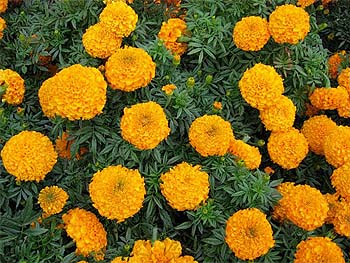
Variety Hawaiian- erect marigolds (tall) with a high bush and strong stems 90 cm high, carnation-shaped inflorescences, double, large - up to 12 cm in diameter, with a bright orange color, do not require a garter
Laboratory work No. 6
Target:
Equipment:
Progress:
2. Fill in the table
| Comparable signs | Apple variety name | |||
| Antonovka | White filling | Pepin saffron | Wild apple tree | |
| Fruit color | Yellowish. | Greenish yellow | greenish yellow | |
| Color of the pulp | ||||
| Taste | sweet and sour | sweet and sour | ||
| The size | Fruit middle size(about 90 g). | Wild apple fruit size 2 to 5 cm in diameter. | ||
| Ripening terms |
Output:
Laboratory work No. 11
Topic: Plotting a variation series and variation curve
Target: get acquainted with the patterns of modification variability, the method of constructing a variation series and variation curve.
Equipment: anthropometric data of students (from 10-25: height, separately for boys and girls, leaves of oak, poplar, cherry (or any other plant), beans (20-30 pieces), a simple pencil, pen, notebook, ruler.
Progress:
- Measure the length of the beans (20-30 pieces)
- Build variation range, in which V is the length of the seeds, and P is the frequency of occurrence. Fill the table.
| V (mm) | ||||||||||||
| P | I | III | IV | IV | V | VI | Vii | Vii | VI | IV | II | I |
3. Plot the variation curve. Mark the highest point on the curve.
4. Measure the height of your classmates, friends.
5. Record the received data in a notebook.
6. Count the number of students with the same height.
7. Complete table 2.
8. Plot the variation curve, which is a graphical expression of the variability of the trait. Mark the height of the students on the horizontal axis and the number (number) of students in the group on the vertical axis.
9. Determine average severity according to the formula: f = n / N, where f is the frequency of occurrence, n is the number of students in the class interval, N is the total number of students.
10. Make a conclusion.
Table "Research results":
Variation curve.
11. Measure the length of the leaves of any plant (20 pieces) and write down their parameters.
12. Determine the number of samples that are similar in terms of the considered attribute.
13. Make a variation series - enter the obtained data into the table, in which in the first line indicate the individual values of the attribute (v), and in the second line - the frequency of occurrence each value (p)
14. Plot the variation curve - display on the graph the relationship between the value of the trait and the frequency of its occurrence.
Variation curve.
15. Make a conclusion about what pattern of modification variability you found.
Allows to reveal the patterns of modification variability in the mass of random phenomena and to determine their practical significance. A variation series of modification variability was found here. Variational row - row modification variability of the properties of an organism, which consists of individual properties of modifications, arranged in the order of increasing or decreasing the quantitative expression of the property.
16. What are the biological reasons for the distribution of variants in the variation series? What does the variation curve show? Formulate your conclusion.
In the variation series, the properties are arranged in order of increasing or decreasing the quantitative expression of the properties (leaf size, change in the intensity of growth, etc.). A single indicator of the ratio of two factors in a variation series (for example, the length of the coat and the intensity of its pigmentation) is called a variation. Variation Curve - Displays both the range of variation of a property and the frequency of an individual variation. The curve shows that the most common are the average variants of the manifestation of the trait.
Conclusion: Modification (phenotypic) variability - changes in the body associated with a change in the phenotype due to the influence of the environment and are, in most cases, adaptive in nature. In this case, the genotype does not change. Generally modern concept"Adaptive modification" corresponds to the concept of "certain variability", which was introduced into science by Charles Darwin. A variation series is a series of modification variability of an organism's properties, which consists of individual properties of modifications, arranged in the order of increasing or decreasing the quantitative expression of the property (leaf size, change in the intensity of growth, etc.). A single indicator of the ratio of two factors in a variation series is called a variant. Variation Curve - Displays both the range of variation of a property and the frequency of an individual variation. The curve shows that the most common are the average variants of the manifestation of the trait (Quetelet's law). The reason for this, apparently, is the effect of environmental factors on the course of ontogenesis.
Laboratory work No. 10
Laboratory work No. 13
The rule of ecological pyramids very conditionally conveys the pattern of energy transfer from one nutritional level to the next, in the food chain. For the first time these graphic models were developed by Charles Elton in 1927. According to this pattern, the total mass of plants should be an order of magnitude larger than herbivorous animals, and the total mass of herbivorous animals should be an order of magnitude larger than predators of the first level, etc. to the very end of the food chain.
Laboratory work No. 1
Option number 1.
Table number 1 "Similarities and differences between plant and animal cells."
| Features of the structure of the cell | Plant cell | Animal cage |
| Drawing | ||
| Similarities | Nucleus, cytoplasm, cell membrane, mitochondria, ribosomes, Golgi complex, lysosomes, self-renewal ability, self-regulation. | Nucleus, cytoplasm, cell membrane, mitochondria, ribosomes, lysosomes, Golgi complex, self-renewal ability, self-regulation. |
| Difference traits | There are plastids (chroloplasts, leukoplasts, chromoplasts), a vacuole, a thick cell wall consisting of cellulose, capable of photosynthesis. Vacuole - contains cell juice and accumulates in it toxic substances(plant leaves). | Centriole, elastic cell wall, glycocalyx, cilia, flagella, heterotrophs, storage substance - glycogen, integral cell reactions (pinocytosis, endocytosis, exocytosis, phagocytosis). |
Option number 2.
Table No. 2 " Comparative characteristics plant and animal cells ".
| Cells | Cytoplasm | Core | Dense cell wall | Plastids |
| Plant-naya | The cytoplasm consists of a thick viscous substance in which all other parts of the cell are located. She has a special chemical composition... Various biochemical processes take place in it, ensuring the vital activity of the cell. In a living cell, the cytoplasm is constantly moving, flows over the entire volume of the cell; it can increase in volume. | contains genetic information that performs the main functions: storage, transfer and sale hereditary information with the provision of protein synthesis. | There is a thick cell wall composed of cellulose. | There are plastids (chroloplasts, leukoplasts, chromoplasts). Chloroplasts are green plastids that are found in the cells of photosynthetic eukaryotes. With their help, photosynthesis takes place. Chloroplasts contain chlorophyll, the formation of starch with the release of oxygen. Leukoplasts - synthesize and accumulate starch (the so-called amyloplasts), fats, proteins. Found in plant seeds, roots, stems and flower petals (attract insects for pollination). Chromoplasts - contain only yellow, orange and reddish pigments from a number of carotenes. They are found in the fruits of plants, give color to vegetables, fruits, berries and flower petals (attract insects and animals for pollination and distribution in nature). |
| Animal | Present, it consists of a colloidal solution of proteins and other organic matter 85% of this solution is water, 10% is proteins and 5% is other compounds. | containing genetic information (DNA molecules), performing the main functions: storage, transmission and implementation of hereditary information with the provision of protein synthesis. | Present, elastic cell wall, glycalyx | No. |
4. Formulate your conclusion.
Output: _All plants and animals are made up of cells. A cell is an elementary unit of the structure and vital activity of all living organisms. A plant cell has a thick cellulose membrane, vacuole and plastids, animals, unlike plants, have a thin glycogenic membrane (it carries out pinocytosis, endocytosis, exocytosis, phagocytosis), and there are no vacuoles (except for the protozoa).
Laboratory work No. 2
Progress
1. Remove the bottom skin of the onion scales (4mm 2);
2. Prepare a micropreparation, examine and sketch 4-5 cells of what you saw;
3. On one side of the cover glass, apply a few drops of sodium chloride solution, and on the other side, draw off the water with a strip of filter paper;
4. Examine the slide for a few seconds. Pay attention to the changes that have occurred with the cell membranes and the time during which these changes have occurred. Draw the changed object.
5. Apply a few drops of distilled water to the edge of the coverslip and pull it off the other side with filter paper, rinsing the plasmolyzing solution.
6. Examine the slide under a microscope for a few minutes. Note the changes in the position of cell membranes and the time during which these changes occurred.
7. Compare what you see with the image of the object in Figure 1.
8. Sketch the object of study.
Plasmolysis formation in the cell
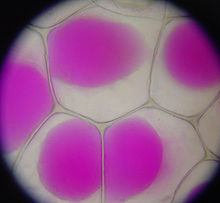 The cells stretched out, began to lose their shape. The parietal layer of the cytoplasm separated from the hard shell of the plant cell, as water was lost.
The cells stretched out, began to lose their shape. The parietal layer of the cytoplasm separated from the hard shell of the plant cell, as water was lost.
Cell in plasmolysis
9. Make a conclusion in accordance with the purpose of the work, noting the speed of plasmolysis and deplasmolysis. Explain the difference in speed between the two processes.
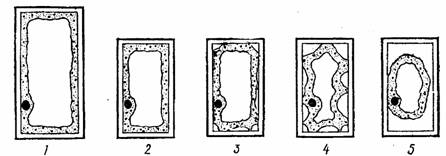
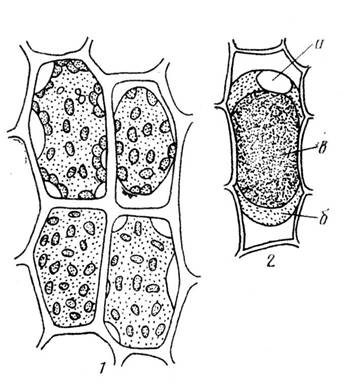
Deplasmolysis occurs more slowly than plasmolysis.
Answer the questions:
1. Where did the water move (into or out of cells) when the tissue was placed in a salt solution?
Water moves from the cell into the solution, while the concentration of Na + ions tends to equalize outside and inside the cell.
2. How can this direction of movement of water be explained?
Laboratory work No. 6
Topic: Study of the results of artificial selection
Target: to reveal the similarities and differences of plant varieties as a result of the implementation of the tasks set by man in the course of artificial selection.
Equipment: dummies different varieties apples, pears, illustrations of various breeds of animals, varieties of plants.
Progress:
1. Consider the proposed varieties of apples, find similarities and differences with their wild ancestor.
2. Fill in the table
| Comparable signs | Apple variety name | |||
| Antonovka | White filling | Pepin saffron | Wild apple tree | |
| Fruit color | Yellowish. | Greenish yellow | greenish yellow | green-yellow, often red or whitish-yellow |
| Color of the pulp | Slightly yellowish, juicy, medium density, granular. | white, friable, tender, coarse-grained, juicy enough at optimum maturity, sweet and sour taste with excess acid, with a weak aroma. | creamy, dense, juicy, wine-sweet taste with a spicy delicate aroma, good taste. | white, aromatic, dense, winter ripening. |
| Taste | The taste is good, with some excess of acid and a peculiar aroma. | sweet and sour | sweet and sour | sour or sweet and sour, sometimes with bitterness. |
| The size | The size of the fruit depends on the clones and the weather conditions of the year. | The fruit is round, medium and large in size (80-130g). | Fruit middle size(about 90 g). | Wild apple fruit size 2 to 5 cm in diameter. |
| Ripening terms | The ripening period depends on the meta growth. It is usually harvested in late September and early October. | Variety summer term ripening. Fruits ripen in late July - early August. | Saffron Pepin is a typical autumn variety. The fruits are harvested in late September - early October. | From mid-August to mid-and sometimes late October. |
3. Explain the reasons for the differences, formulate a conclusion.
They were located in different areas, and each species was affected by a certain environment characteristic for him. They differ geographically and ecologically. They differ in the type of fruiting.
Output: Artificial selection results in a variety of plant varieties and animal breeds. Artificial selection is one of the main breeding methods that can be used both independently and in combination with other methods. For example, hybridization of closely related organisms provides a wide range of variability, which serves as a fruitful material for artificial selection. Artificial selection was the main factor in the emergence of domestic animals and cultivated plants. The concept of artificial selection includes the selective selection of animals or plants by a breeder, in which, under the influence of the external environment and a change in habits, adaptations have arisen that are useful not for the animal or plant itself, but for humans.
Laboratory work No. 11
LABORATORY WORK No. 3
Topic: Study of plant variability. Construction of a variation series and variation curve.
Purpose: To study the statistical patterns of modified variability, to learn to assess the nature of the variability of the trait under study, to build a variation series and a variation curve.
Equipment and materials: herbarium specimens of plants, acacia leaves, rulers, magnifiers.
Progress
1-2. Let's consider several herbarium specimens of plants of the same species, for example, wheat, and compare them with each other. They differ in insignificant traits - the size of the stem, the number of caryopses in the spikelets, the length of the leaf, and the like.
The main species characteristics of different wheat individuals are unchanged: the structure of the flower, the type of inflorescence, the type of stem, or the type of fruit.
Compare different types cereals to determine by what characteristics they differ, and by some similar ones.
Comparative characteristics of plants of the Cereal family
|
Signs |
||||
|
Life |
||||
|
Root |
fibrous type |
fibrous type, very branched |
fibrous type |
|
|
upright, straw, 40-50 cm |
upright, straw, 50-60 cm |
|||
|
simple, sedentary, linear; small tongue and ears |
simple, sedentary, linear; big tongue, no ears |
simple, sedentary, linear; short tongue, large ears |
||
|
inconspicuous, yellowish greenish |
inconspicuous, yellowish greenish |
small, inconspicuous, yellowish greenish |
||
|
Inflorescences |
complex ear |
complex ear |
||
|
weevil |
weevil |
weevil |
3. Thus, wheat, oats and barley have a lot common features, which unite them into the Zlakov family. They have the same root system, the hollow stem is straw, the structure of flowers and fruits is similar. The types of cereals can be distinguished by the most reliable indicator - the structure of the inflorescences. In wheat, the inflorescence is a complex ear of 3-7 simple spikelets, and oats have a panicle inflorescence. If the inflorescences have not yet appeared, the species are distinguished by the presence of reeds and ears - filmy outgrowths at the place of transition of the leaf blade into the vagina.
Differences between individuals of the same species are explained different conditions existence. They cause modification of variability.
These are changes in the phenotype acquired during the individual development of the organism. For example, in wheat, this is the length of the stem, leaves, the size of the caryopses, and the like.
Modifications are adaptive and not inherited through sexual reproduction. In many plants, modifications are inherited through vegetative propagation.
4-6. Investigation of statistical patterns of variability of modification
1. Compilation of the variation series of modified variability (for example, 10 leaf blades of acacia).
|
Sheet size (cm) |
||||||||
|
Feature frequency (pcs.) |
The size of the leaf blades - option (V).
The frequency of manifestation of the sign - R.
The total number of leaf blades - n (10 pcs.) Determine the average value of the trait (M) by the formula:
Let's construct the variation curve of the modified variability. To do this, on the abscissa axis we postpone the options (V), and on the ordinate axis - the frequency of manifestation of the feature (G)
From the variation series and the variation curve it can be seen that the rate of response of a trait has certain limits.
The sizes of leaf blades range from 1 to 3 cm. The largest number of variants falls on the middle part of the row, which corresponds to the average value of the trait (G = 2.02 cm).
Modification variability is a change in the phenotype caused by the influence of environmental conditions. The length of the series and the range of modified variability depends on environmental conditions. The more stable they are, the shorter the variation range. Modification changes are adaptive in nature and help to adapt to changes in environmental conditions.
Laboratory work Study of variability, species criteria, results of artificial selection on varieties of cultivated plants Author-compiler: Bobrovskaya Elena Vasilievna. Biology teacher MBOU "Lyceum" Erudite ", Rubtsovsk, Altai Territory. The lesson in the 11th grade is the profile level. UMK Zakharov. Textbook: V.I. Sivoglazov, I.B. Agafonov, E.T. Zakharova. Biology general biology classes.
Purpose: to identify the distinctive features of plants of the same species, different varieties Type of cultivated plant: upright marigolds Objectives: 1. To study the features of the external structure of plants 2. To read the description of the erect marigold varieties 3. To indicate the distinctive features 4. Based on the studied tagetis varieties, draw conclusions about distinctive features plants of the same species, but different varieties


Marigolds erect or African Tagetes erecta Family: Asteraceae (Asteraceae) Homeland: Southern Mexico The bush is compact or spreading with a pronounced main shoot. Stems strongly branched, cm tall, glabrous, erect, finely ribbed, branched, lignified at the base, lateral shoots directed upwards, form bushes of reverse pyramidal shape. They form woody at the base. Leaves pinnately-divided with lanceolate, sharp lobes, serrate along the edge, from light to dark green, arranged in regular order. The color of the inflorescences is monochromatic. Inflorescences are large baskets 6-15 cm in diameter, single, simple, semi-double or double, on long peduncles. Blooms from late June - early July. The color of the inflorescences is monochromatic, light yellow, yellow, bright yellow, orange or bicolor. In 1 g, up to 300 seeds that remain viable for 1-2 years. Most of the classic terry varieties belong to this particular type of marigold. Homeland - Southern Mexico. In culture since the 16th century. Varieties are distinguished by height: giant - above 90 cm; high cm; medium cm; low - up to 45 cm in height.

Essential oil is used in the production of oriental confectionery, in the alcoholic beverage, soap-making and perfumery and cosmetic industries. Aromatize tea with marigold flowers. In folk medicine, an aqueous infusion of flower baskets was used as a urine, diaphoretic and antihelminthic agent. The content of essential oil of marigolds in the aerial part of flowering plants is 0.30-0.55%, in the budding phase - 0.22-0.30%; it is maximal in inflorescences (0.45%) and leaves (0.28%). Essential oil of yellow or brown color, mobile, floral-spicy smell with fruity tones. Its main component is ocimene (50%); D-pinene, sabinene, myrcene, limonene, n-cymene, citral, linalool, D-terpinene are also present. Cultivated as an ornamental plant. Recommended for flower beds, ridges, tall groups, vases, balconies, cuttings. Erect marigolds can be grown for cutting. They stand in water for about three weeks. They are used in all types of flower beds. They are not suitable only for a pond and a shady garden.
![]()
Tagetes erecta Antigua Gold, Primrose, Orange The "Antigua" variety belongs to the group of erect, undersized - up to 20 cm high - border tegetes. Plants with a strong, branching stem. Inflorescences are large baskets 6-13 cm in diameter, single, simple, semi-double or double, on long peduncles. Abundant flowering, long lasting inflorescences per plant.

The Mary Helen variety is erect marigolds (tall). An excellent variety, with a high bush up to 90 cm high, terry inflorescences, clove-shaped, hemispherical up to 1012 cm in diameter. Bright lemon-yellow, used for flower beds, ridges, tall groups against the background of a lawn, very good for cutting.

Marigolds erect Lemon Prince One of the most common annual plants of the Astrov family. Forms a shrub 70 cm high with a distinct main shoot. Inflorescences are large (8-10 cm in diameter), densely double, spherical, lemon-yellow in color. Blooms from June to September. Photophilous and thermophilic, they do not tolerate frost. They are undemanding to soils, but they prefer fertile light soils. As a rule, they are grown in seedlings. Sowing is carried out in the second half of March and early April. Seedlings appear 4-8 days after sowing, seedlings dive in the phase of the 2nd true leaf. Seedlings are planted in early June, the distance between plants, see. Used for planting in flower beds, in groups, for cutting.
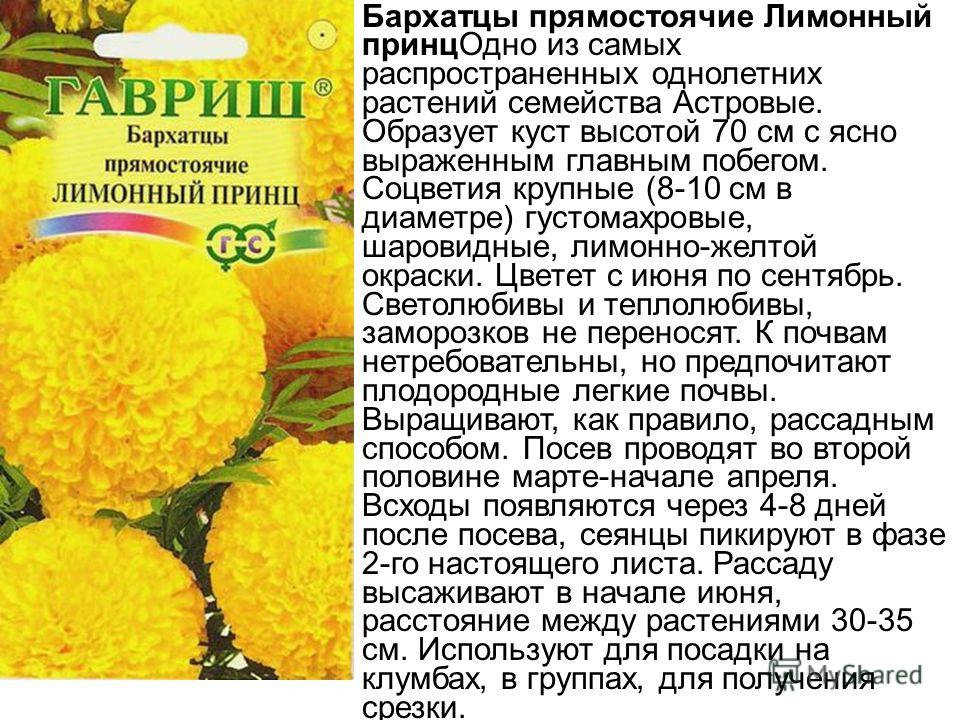
Stems are erect, 35 cm tall. The inflorescences of the basket are up to cm in diameter, dark orange in color. V open ground sown in late May and early June. Shoots appear on the 5-10th day. Seedlings are sown in late March - early April. Blooming will begin in June. Marigolds planted next to garden crops reduce their damage fungal diseases, especially Fusarium, protect against certain types of nematodes.

Forms a shrub cm in height with a pronounced main shoot. Inflorescences are densely double, cm in diameter. Blooms from June to September. Photophilous and thermophilic, they do not tolerate frost. They are undemanding to soils, but they prefer fertile light soils. As a rule, they are grown in seedlings. Sowing is carried out in the second half of March and early April. Seedlings appear 4-8 days after sowing, seedlings dive in the phase of the 2nd true leaf. Seedlings are planted in early June, the distance between plants, see. Used for planting in flower beds, in groups, for cutting.

Stems are erect, 20 cm tall, strongly branched from the base, lateral shoots are deflected. Inflorescences of a basket of bright orange, cm in diameter. It can be sown in open ground in late May and early June. Shoots appear on the 5-10th day.

Stems are erect, 20 cm tall, strongly branched from the base, lateral shoots are deflected. The inflorescences of the basket are bright lemon-yellow, cm in diameter. It can be sown in open ground in late May and early June. Shoots appear on the 5-10th day.


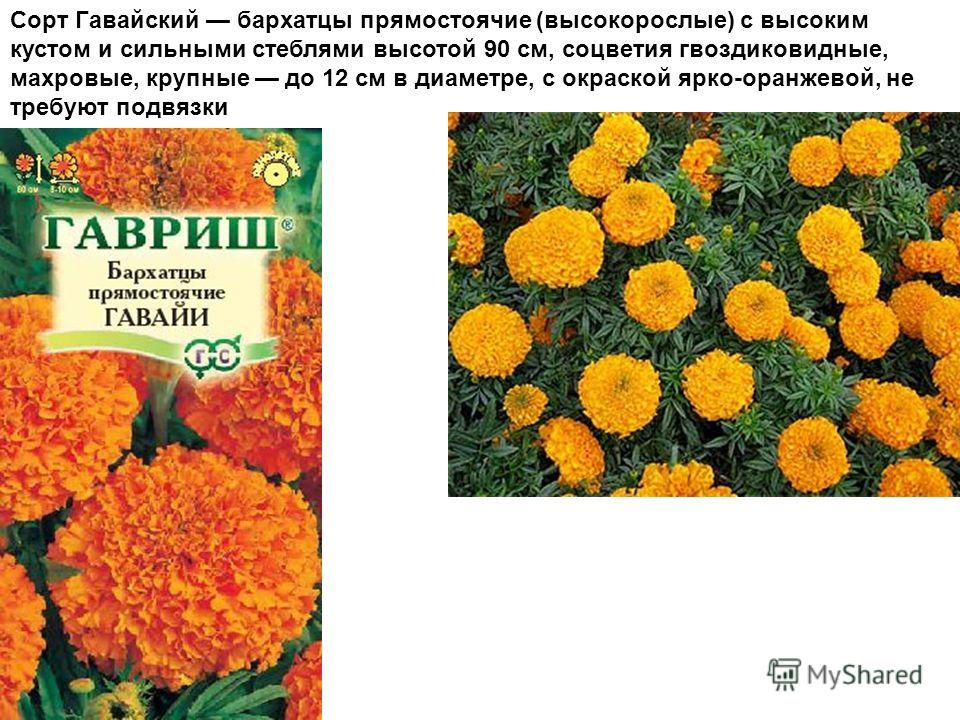
Information sources Literature: 1. Borodin PM, Vysotskaya LV, Dymshits GM. Biology. General biology classes. Textbook for educational institutions. Profile level. Part 1 / Ed. VC. Shumny, G.M. Dymshitsa - M .: Education, - 303 p. 2. Biology. General biology: workshop for students of class. general education. Institutions: profile level / G.N. Dymshits, O.V. Sablina, L.V. Vysotskaya, P.M. Borodin; Grew up. acad of sciences, grew up acad. education, publishing house "Education". - M: Education, - 143 p. 3. General Biology: A textbook for classes with advanced study of biology in school. Vysotskaya L.V., Dymshits G.M. et al. (2001, 264 pp.) General biology: A textbook for classes with in-depth study of biology at school. Vysotskaya L.V., Dymshits G.M. and others. 4. Biology in tables and diagrams. Compiled by Onishchenko A.V. (2004, 128 p.) Biology in tables and diagrams. Compiled by Onishchenko A.V. (2004, 128 p.) Internet sources: Description of plants: Sources of illustrations: Photos of varieties, species of marigolds: 1.http: //flower.onego.ru/annual/tagetes.htmlhttp: //flower.onego.ru/annual /tagetes.html 2.http: //www.flowerbank.ru/? p = 760 http://www.flowerbank.ru/? p = 760 3.http: //sazhaemsad.ru/naryadnye-cvety-barxatcy.htmlhttp : //sazhaemsad.ru/naryadnye-cvety-barxatcy.html



